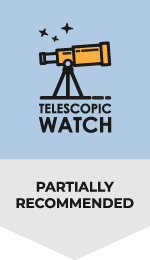Optical Tube Performance of Nexstar 5SE
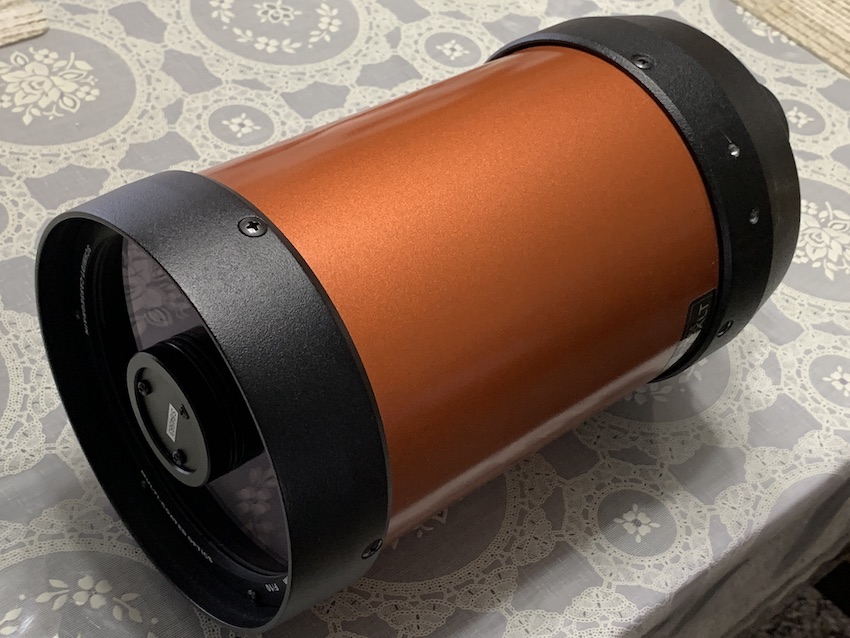
The Celestron NexStar 5SE computerised telescope is based around the C5 optical tube, a telescope with 45 years of heritage that has flown on Space Shuttle missions. The C5 is a Schmidt-Cassegrain. This means it does have a long focal length of 1250 mm, limiting its field of view somewhat, especially given the scope’s 1.25”-only eyepieces. To some extent, the scope is also “boxed in” to high magnifications.
A 2” diagonal can in fact be attached to the 5SE, but wide-field 2” eyepieces will vignette to the point that it’s not really worth the bother. The same is true of a dedicated f/6.3 reducer. Unlike other Celestron SCTs, the C5 also lacks Fastar/Hyperstar capability.
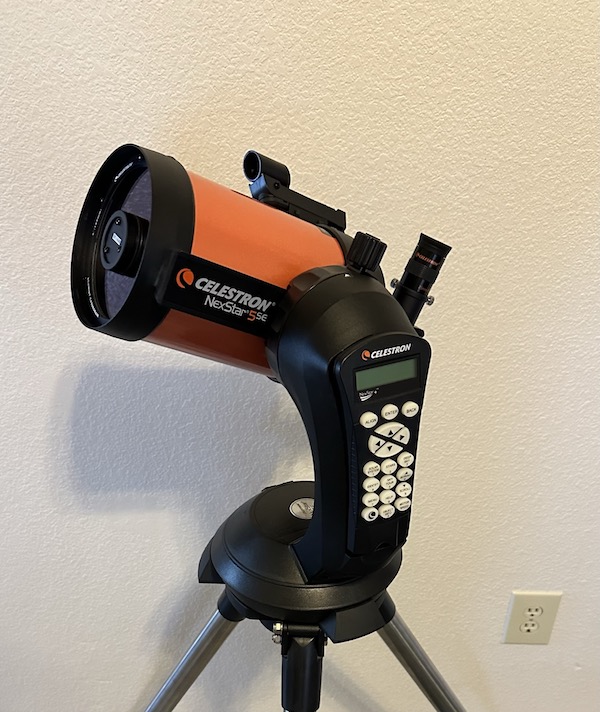
The Celestron NexStar 5SE’s 5” aperture is enough to show a fair amount of detail on the Moon and planets. However, its large secondary mirror, which obstructs 38% of the diameter, severely hampers resolution and contrast compared to a 5” Newtonian or Maksutov-Cassegrain, let alone a refractor. It also reduces the light gathering ability (already fairly small) by a fair amount.
As with most decent telescopes, the Celestron NexStar 5SE optical tube comes with a Vixen-style dovetail, which allows for easy, tool-free attachment and balancing on its mount as well as numerous Celestron and third-party alt-azimuth and equatorial mounts which use Vixen saddles.
The 5SE does need to be collimated occasionally as it is a Schmidt-Cassegrain.
Having a Closer Look at the Accessories
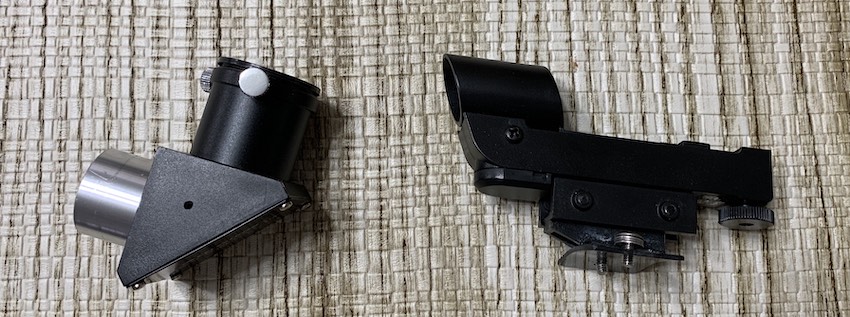
The 5SE comes with a single 25mm 1.25” Plossl eyepiece, which provides 50x magnification, though you may want a 32mm Plossl and/or the aforementioned reducer-corrector for the widest field of view at low power. Additional medium and high magnification eyepieces of shorter focal length would be good to get the most out of your Celestron NexStar 5SE.
A quality 1.25” prism star diagonal is also provided for comfortable viewing, as is Celestron’s StarPointer red dot sight, which is used for star aligning the telescope during setup.
Reviewing the Mount Features
The Celestron NexStar SE mount is an upgraded version of the original NexStar 5 mount, which was first released in the early 2000s.
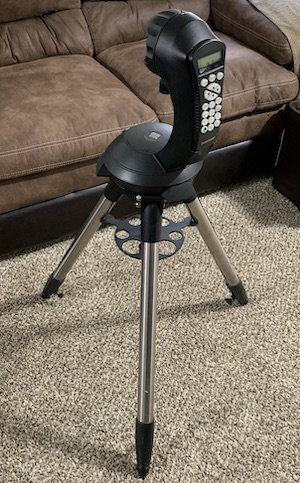
It’s a simple alt-azimuth GoTo mount with a Vixen dovetail saddle that runs off fairly cheap servo motors. The NexStar mount is capable of pointing to something like 40,000 objects in its database, most of which are simply stars and consequently of little interest to the 5SE or indeed any telescope. A good chunk of the deep-sky objects in its database are also invisible with the Celestron NexStar 5SE telescope, on account of their meagre brightness or being in the wrong hemisphere of the sky to be seen from your location.
While this whole design works, the hand controller’s small buttons make it all too easy to push the wrong one, especially with gloves or simply large fingers. It also consumes batteries very quickly; you’ll need a 12-volt power supply for this scope. Lastly, entering the time and date is required on every boot of the mount, unless you obtain Celestron’s SkySync GPS accessory or their SkyPortal WiFi adapter, either of which costs over £70 as of the time of this writing. The SkyPortal WiFi adapter also mitigates the annoyance and limitations of a traditional hand controller by allowing you to control the scope with your phone, at the expense of drawing significantly more electrical power from your scope/battery as well as eating up your phone’s battery charge. The SE mount is pretty steady, but it can still be bumped. If this happens, one must re-boot and realign the mount.
The Celestron NexStar 5SE comes with a built-in equatorial wedge, so in theory, one can polar align it and do long-exposure astrophotography. However, the wedge has no fine adjustments and cannot be adjusted in azimuth, so it is basically useless. Additionally, the mount’s low-precision gears and the 5SE’s long focal length make it ill-suited for long-exposure astrophotography anyway.
Should I buy a used NexStar 5SE?
A used Celestron NexStar 5SE is a decent scope. Keep in mind that you will still have to buy additional eyepieces to get the most out of the 5SE unless the seller is nice enough to throw some in.
Alternative Recommendations
Under £800
- The StellaLyra 10″ f/5 Dobsonian offers twice the resolution and over quadruple the light-gathering capacity compared to the Celestron NexStar 5SE, due to its impressive 10″ primary mirror. Included with the telescope are a variety of accessories, such as a 2″ low-power, 30mm focal length wide-angle eyepiece, a 9×50 finder scope, and a 9mm high-power Plossl eyepiece. The Dobsonian mount is simple to aim, quick to set up, and more stable than the 5SE’s computerized mount.
- The Celestron StarSense Explorer 8″ Dobsonian provides some computerized pointing capabilities, though no motorized tracking, with StarSense Explorer technology and, of course, possesses superior light gathering and resolving power to the 5SE with its 8″ aperture on a stable Dobsonian base. The telescope is easy to set up, transport, and use, though the number of accessories is limited compared to other options.
- The Sky-Watcher Virtuoso GTi 150P provides a 50% increase in light-gathering ability, superior optics, a wider field of view, and slightly higher resolution compared to the NexStar 5SE. With fully motorized tracking and GoTo technology, it features the FreedomFind encoder system to allow for manual aiming by hand too, regardless of whether the mount is powered on or aligned, and is controlled via your smartphone or tablet instead of a hand controller. Its collapsible tube ensures easy transportation, and its short focal length delivers a wide field of view, ideal for deep-sky observation. The Heritage 150P, a more budget-friendly alternative, is identical to the Virtuoso GTi 150P but lacks electronics.
- The Sky-Watcher Skymax 127 AZ-GTi combines the exceptional Skymax 127 Maksutov-Cassegrain optical tube with the versatile AZ-GTi mount and tripod, delivering motorized tracking GoTo functionality like the 5SE that can be operated through your smartphone, or simply pushed around the sky by hand thanks to its FreedomFind encoders. The Skymax 127 Virtuoso GTi offers the same features but is mounted on the Virtuoso GTi tabletop Dobsonian mount, with the possibility to connect it to a third-party tripod. The Skymax 127 optical tube beats the C5 XLT/5SE on the Moon, planets, and double stars and only suffers slightly worse performance when it comes to viewing deep-sky objects.
Over £800
- The Celestron StarSense Explorer 10″ Dobsonian delivers four times the light gathering ability and twice the resolving power of the NexStar 5SE, with Celestron’s StarSense Explorer technology providing an assist in aiming this telescope manually around the night sky. The base is fairly lightweight for a 10” Dobsonian and transportation is made easier with cutouts in the base and handles on the tube. Although this telescope comes with minimal accessories besides the StarSense Explorer technology, it offers great value in terms of aperture and portability for its price.
- The Celestron NexStar 6SE is similar to the 5SE in design and features, but its C6 XLT optical tube offers better light gathering and resolving power, a smaller secondary mirror obstruction, sharper images, and HyperStar compatibility on a steadier mount than the 5SE. Despite the minimal increase in weight, bulk, or price, the 6SE offers significantly more capability and value for your money than the 5SE.
- The Sky-Watcher Skyliner 250P FlexTube GoTo Dobsonian not only features twice the resolution, 4x the light-gathering power of the NexStar 5SE and of course full motorized tracking/GoTo, but also has Sky-Watcher’s FreedomFind encoder system to allow you to aim the telescope manually as you wish with no ill affect to the alignment or motors in the mount.
- The Celestron NexStar Evolution 6 is similar to the NexStar 6SE, sharing the C6 XLT optical tube, but offers various mechanical enhancements compared to the more affordable NexStar 6SE. It also includes a built-in Wi-Fi adapter and lithium battery, making setup and use more straightforward.
Aftermarket Accessory Recommendations
The NexStar 5SE package comes with hardly any accessories besides its diagonal and lone 25mm Plossl eyepiece, making it essential to purchase several key upgrades and additional eyepieces to get the most out of this telescope. We highly recommend a dew shield for the 5SE, as with any catadioptric telescope, to minimise glare from nearby light sources entering the telescope, as well as to slow down frost or dew forming on the 5SE’s front corrector plate, and to keep pollen, dirt, and dust away.
A 1.25” 32mm Plossl eyepiece for 39x with the NexStar 5SE provides a slightly wider field of view and lower magnification than the provided 25mm Plossl, better for viewing deep-sky objects. A 2” star diagonal and eyepieces will vignette with the NexStar 5SE, as will any attempt to increase the field of view with an f/6.3 reducer and low-power eyepieces, so there’s little point in obtaining either. For medium magnification, we recommend a 1.25”, 16mm UWA (78x) or the more affordable 15mm redline/goldline (83x). For higher magnification, a 9mm redline or goldline (138x) eyepiece is ideal, while a 6mm redline or goldline (208x) provides the maximum useful magnification that the 5SE can be expected to deliver.
A UHC (ultra high contrast) nebula filter can substantially improve views of many nebulae, such as the Orion Nebula, when used with the NexStar 5SE, especially under light-polluted conditions. It’s best to use with your lowest-power eyepiece like the provided 25mm Plossl or preferably an aftermarket 32mm unit for even lower magnification. While it’s not a miracle cure for light pollution and is only effective for nebulae, it is helpful for improving your views of them nonetheless. The C5 XLT’s long focal length and resultingly limited field of view further restrict your target selection compared to a faster f/ratio Dobsonian of similar aperture to the 5SE, but a UHC filter is undoubtedly a useful asset for your astronomy equipment collection.
Finally, you’ll want a power supply such as the Celestron PowerTank Lithium or a Talentcell power pack to avoid exhausting too many disposable batteries with the 5SE and to avoid the chaos of dealing with an extension cord. If desired, the 5SE can also be controlled over WiFi with the Celestron SkyPortal app or SkySafari Pro using the SkyPortal WiFi adapter, emulating the Astro Fi and NexStar Evolution telescopes but with a sturdier mount than the former and a much lower price tag than the latter.
What can you see with the Celestron NexStar 5SE?
The 5SE’s small aperture and narrow field of view make it primarily a lunar, planetary, and double star instrument. It’ll show you lunar craters and mountains just a few miles wide, the phases of Venus and Mercury, the cloud belts of Jupiter and Saturn, Jupiter’s Great Red Spot and the Cassini Division in Saturn’s rings, the two gas giants’ various moons, and you’ll be able to see Uranus and Neptune as bluish, star-like dots. The NexStar 5SE will also have no trouble splitting double stars as close as an arc second apart under clear and steady skies.
As for deep-sky objects, the Celestron NexStar 5SE’s small aperture is the biggest limiting factor, even under dark skies. You’ll be able to spot most of the objects in the Messier catalogue and view globular clusters and galaxies, but resolving individual stars in globular clusters – as well as details in most galaxies, such as spiral arms or dust lanes – will be challenging, even if you are in dark skies far from light pollution. From the suburbs, the 5SE is likely to disappoint in all but the brightest nebulae and star clusters such as M42, M27, and M13.

